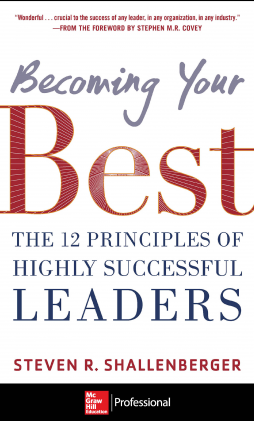Is there a secret to success that only a few successful leaders know? Well if not a secret, is there something that you can decode by analyzing the lives and working styles of successful leaders and imbibe those attributes in you? The author of Becoming Your Best presents these unique attributes of successful leaders, which he has synthesized by evaluating and critically analyzing hundreds of leaders around the world. The author claims that the principles in this book are the common thread that binds these successful personalities and will help you become the best at leadership.
There is, of course, much more to success and leadership than just adopting a few attributes, however, people who are on the cusp of taking a leadership position or aiming for one will surely benefit from the points discussed here by the author.
For more than 25 years, Steve Shallenberger was one of Stephen Covey’s top executives and helped build the Covey Leadership Center. He was involved in the planning and publication of The 7 Habits of Highly Effective People and First Things First. He is also the founder of Synergy Companies, an industry leader in energy management and environmental solutions.
 Becoming Your Best: The 12 Principles of Highly Successful Leaders
Becoming Your Best: The 12 Principles of Highly Successful Leaders
Author: Steven R. Shallenberger
Publisher: McGraw-Hill; 1 edition (October 28, 2014)
ISBN: 0071839984, 978-0071839983
The book is organized in three parts, which you can look at as the three spheres or pillars of becoming a highly successful leader and the best at what you do: Leadership, which covers the professional actions of a leader; Transformational Teams and Relationships, which covers the rules of interaction with others at work and otherwise; Transformational Living, which is about using the best in yourself.
The first chapter, Be True to Character, is a lesson in moral science you had in your primary school, or not. But it helps to remind leaders that in their position, following these tenets is more important because of their position of power, after all – “With Great Power, comes Great Responsibility.”
The author illustrates each of these important pointers to true character with examples of leaders such Mahatma Gandhi and Nelson Mandela. The readers who are short on time or need a refresher moral science course can refer to the summary or Leadership Action Steps outlined at the end of this and similarly at the end of other chapters throughout the book.
One of the most important attributes of great leaders throughout the history was their vision. They envisioned something unthinkable at that time and mobilized masses to achieve, no, realize that vision. Organizations that do not have visionary leaders fail to mobilize sustained support. Mahatma Gandhi had a vision for India that surpassed the immediate goal of freedom from the British Raj. Dr. Martin Luther King had a vision for equal rights that went beyond abolishment of segregation. The vision here was much more than individual gains, included everyone, and created many more leaders. In Lead with a Vision, the author puts forth his checklist for what a vision should be like.
Trust is central to any relationship: business or personal. Lack of trust can cloud your as well as other people’s judgments and make them take decisions they wouldn’t if a trust was established. Lack of trust in a professional relationship tends to slow down work and wastes time and energy as people begin to second guess actions and think about insulating themselves. For example, you will blindly buy a product from brand with which you had a positive sales and customer service experience. On the other hand, for some reason, if you had to buy from a brand that you had a very difficult time few years earlier, you would check, double-check, and recheck every document and get all promises in writing from the company before buying the product. Build and Maintain Trust gives business leaders a primer on how to establish trust in business transactions as well as professional relationships.
The last part of the book focuses on You. The author instructs on how to assess the external environment to identify opportunities and threats and ensure that you address them regularly. Being at peace with oneself is important to function at an optimum level. Internal turmoil can lead to self-doubt. In the last two chapters the author focuses on these two enemies within you and inspires you to persevere and work hard toward success.
Becoming Your Best presents the unique attributes of successful leaders, synthesized by evaluating and critically analyzing hundreds of leaders around the world. The author claims that the principles in Becoming Your Best are the common thread that binds these successful personalities and will help you become the best at leading people.